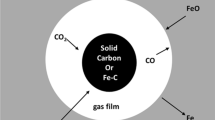Abstract
TDI's synthetic plant generates about 5 mass % of tar by phosgenation process, which has been currently a bottleneck needed to be broken through for the worldwide TDI companies. At present, the reduction fraction of TDI tar is up to 48% relative to the mass of tar and renders the residue of solid crust known as TDI char. In this study, a suasive and effective reduction method has been found, the supercritical methanol is executed to depolymerize the TDI char, and in short, the char can be readily methanolyzed at supercritical state of methanol. With the outstanding depolymerization capability than various existing approaches, the destruction fraction can achieve 81 mass % at supercritical point. A best value as high as 95 mass % is first discovered at 270 °C, exceeding the efficiency at supercritical state. Characterizations of the intrinsic properties of raw char and char remnant after methanolysis have been implemented by TGA, DSC, FT-IR and SEM-EDS. For industrial applications, the diverse methodologies for recovering TDI or related components by alkaline hydrolysis, distillation, vacuum distillation and thermolysis are also discussed and compared with methanolysis in order to recognize the optimal abatement technique.






Similar content being viewed by others
Abbreviations
- ATR:
-
Attenuated total reflectance
- DNT:
-
Dinitrotoluene
- DSC:
-
Differential scanning calorimeter
- DTG:
-
Derivative thermogravimetric curve
- EDS:
-
Energy-dispersive X-ray spectroscopy
- FTIR:
-
Fourier transform infrared spectrometry
- IPA:
-
Isophthalic acid
- MTD:
-
M-toluenediamine
- PCB:
-
Printed circuit board
- PET:
-
Poly(ethylene terephthalate)
- SCF:
-
Supercritical fluid
- SEM:
-
Scanning electron microscopy
- STA:
-
Simultaneous thermal analysis
- TDA:
-
Toluenediamine, o-toluenediamine
- TDI:
-
Toluene diisocyanate
- TGA:
-
Thermogravimetric analyzer
References
Zhan JF. Discussion on TDI recovery technology. ChemEng & Equip. 2013;2:27–8.
Liu TZ, Wang XF, Chen RW. Ren XR Determination of tar content in the process of TDI production. Liaoning ChemInd. 2010;39:338–9.
Zhang LM, Hu YD, Wang X, Wang ZM, Wu LY. Analysis and utilization of TDI tar residue produced by heavy solvent. ChemIndEng Pro. 2015;34:863–6.
Liu J. A preliminary report on the study of 2, 4-diaminotoluene produced by constant pressure hydrolysis of TDI residue. Chin ForInd. 2012;273:284–5.
ASTM D3432–89. Standard test method for unreacted toluene diisocyanates in urethane prepolymers and coating solutions by gas chromatography. West Conshohocken, PA: ASTM International; 1996.
Magyari M, Ábrahám J, Lakatos J. Formation of tars in the TDA-TDI synthesis and experimental study of its removal in the TDI recovery processes. Mater Sci and En. 2015a;40:5–16.
Magyari M, Ábrahám J, Lakatos J. Determination of TDA-tar and TDI-tar content and quantity in TDI synthesis. Mater Sci and En. 2015b;40:17–25.
Fukuzato R. Current status of supercritical fluid technology in the East Asia. In: Proc. 6th Int. Symp. Super. Flu. , Tome 1,2003,1–10.
Motonobu M. Chemical recycling of plastics using sub- and supercritical fluids. J Sup Flu. 2009;47:500–7. https://doi.org/10.1016/j.supflu.2008.10.011.
Genta M, Iwaya T, Sasaki M, Goto M, Hirose T. Depolymerization Mechanism of poly (ethylene terephthalate) in supercritical methanol. IndEngChem Res. 2005;44:3894–900. https://doi.org/10.1021/ie0488187.
Yang Y, Lu Y, Xiang H, Xu Y, Li Y. Study on methanolyticdepolymerization of PET with supercritical methanol for chemical recycling. PolymDegradStabil. 2002;75:185–91. https://doi.org/10.1016/s0141-3910(01)00217-8.
Xiu FR, Zhang FS. Materials recovery from waste printed circuit boards by supercritical methanol. J Hazard Mater. 2010;178:628–34. https://doi.org/10.1016/j.jazmat.2010.01.131.
Ozaki J, Kastria S, Djaja I, Oya A. Chemical recycling of phenol resin by supercritical methanol. IndEngChem Res. 2000;39:245–9. https://doi.org/10.1021/ie9904192.
Allan D, Daly JH, Liggat JJ. Oxidative and non-oxidative degradation of a TDI-based polyurethane form: volatile product and condensed phase characterisation by FTIR and solid state 13C NMR spectroscopy. PolymDegradStabil. 2019. https://doi.org/10.1016/j.polymdegradstab.2018.12.027.
Janković B, Manić N, Stojiljković D. The gaseous products characterization of the pyrolysis process of various agricultural residues using TGA–DSC–MS techniques. J Therm Anal Calorim. 2020;139:3091–106. https://doi.org/10.1007/s10973-019-08733-4.
Santos Borel LDM, de Lira TS, Ataíde CH, de Souza BMA. Thermochemical conversion of coconut waste: material characterization and identifcation of pyrolysis products. J Therm Anal Calorim. 2020. https://doi.org/10.1007/s10973-020-09281-y.
Bacila DM, Lazzarotto M, Hansel FA, Scheuermann GN, Feddern V, Junior AC, Igarashi-Mafra L. Thermal profile of 4,4′-dinitrocarbanilide determined by thermogravimetry–differential scanning calorimetry–mass spectrometry (TG–DSC–MS) and pyrolysis–gas chromatography–mass spectrometry (Py–GC–MS). J Therm Anal Calorim. 2019;138:697–701. https://doi.org/10.1007/s10973-019-08194-9.
GonçalvesNunes WD, Mannochio Russo H, da Silva Bolzani V, Junior CF. Thermal characterization and compounds identification of commercial Stevia rebaudianaBertoni sweeteners and thermal degradation products at high temperatures by TG–DSC, IR and LC–MS/MS. J Therm Anal Calorim. 2020. https://doi.org/10.1007/s10973-020-10104-3.
Chalaris M, Samios J. hydrogen bonding in supercritical methanol a molecular dynamics investigation. J Phys Chem B. 1999;103:1161–6. https://doi.org/10.1021/jp982559f.
Toshio Y, Benmore C, Soper AK. The structure of subcritical and supercritical methanol by neutron diffraction, empirical potential structure refinement, and spherical harmonic analysis. J ChemPhys. 2000;112:8976–87. https://doi.org/10.1063/1.481530.
Acknowledgements
We are grateful to the Fujian Dongnan Electronics Co., Ltd., for providing the samples of TDI char.
Funding
This research was funded by the Science and Technology Development Foundation of ZTRI (Grant number 332017CA0160, 332012CA0080) and the National Natural Science Foundation of China (Grant No. 51878171), Scientific Research Foundation of Fuzhou (2019-G-51), Scientific Research Foundation of the Education Department of Fujian Province (JAT190427) as well as the Scientific Research Foundation of Fujian University of Technology (Grant No. GY-Z160041 and GY-Z160042).
Author information
Authors and Affiliations
Corresponding authors
Additional information
Publisher's Note
Springer Nature remains neutral with regard to jurisdictional claims in published maps and institutional affiliations.
Rights and permissions
About this article
Cite this article
Yu, Gd., Li, Jl., Gong, Lz. et al. Thermolysis and analysis of TDI char by supercritical methanol using TGA, DSC, IR and SEM. J Therm Anal Calorim 146, 2323–2331 (2021). https://doi.org/10.1007/s10973-020-10336-3
Received:
Accepted:
Published:
Issue Date:
DOI: https://doi.org/10.1007/s10973-020-10336-3




